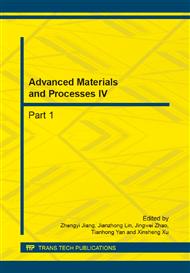p.3
p.7
p.11
p.15
p.21
p.25
p.30
p.34
Enhanced H2 Sensing of SnO2 Nanowires Functionalized with Pt and Pd Catalyst Nanoparticles
Abstract:
SnO2 nanowires with a tetragonal structure were synthesized by thermal evaporation of tin grains at 900 °C. The obtained SnO2 nanowires were doped with Pt and Pd. The morphology, crystal structure, and H2 sensing properties of undoped, Pt-doped, and Pd-doped SnO2 nanowires were investigated. SnO2 nanowires were approximately 30–200 nm in diameter and several tens of micrometers in length. Gas sensors based on undoped, Pt-doped, and Pd-doped SnO2 nanowires showed a reversible response to H2 at an operating temperature of RT–300 °C. The response was improved in the order undoped < Pt-doped < Pd-doped SnO2 nanowire sensors under the same conditions. The highest response upon exposure to 1000 ppm H2 was 252.9 at 100 °C for Pd-doped SnO2 nanowire sensor. The results demonstrated that impurity doping improved the sensor response and lowered the operating temperature at which the sensor response was maximized.
Info:
Periodical:
Pages:
15-20
Citation:
Online since:
September 2014
Authors:
Keywords:
Price:
Сopyright:
© 2014 Trans Tech Publications Ltd. All Rights Reserved
Share:
Citation:


